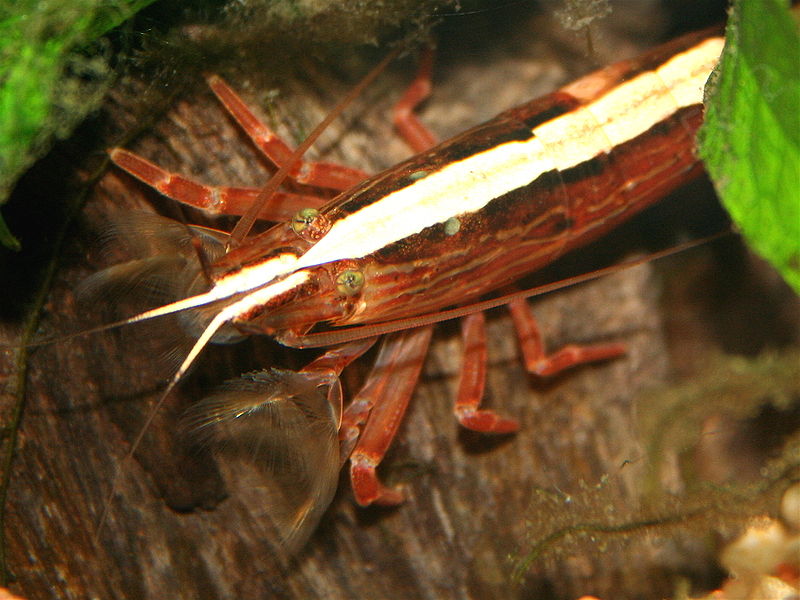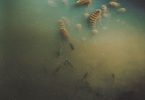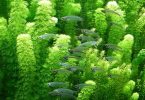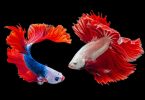Table of Contents
Bamboo Shrimp
Keeping invertebrates are gaining more popularity and bamboo shrimps not only adds the uniqueness not found in other shrimps but are also quite easy to keep and take care of as long as one takes certain things into consideration.
So, in this article: The Complete Care Guide to Bamboo Shrimp, we will be looking at the totality of what it takes to give Bamboo Shrimps the adequate care required for a healthy life and an enjoyable pet keeping endeavor by discussing their habitat, diet, tank mates, health and common diseases amongst other things so that (potential) invertebrates’ pet keepers would have the knowledge they need to make the decision about buying and caring for shrimps.
Shrimp and, by extension, aquatic animals, play a lot more important role in our lives, society, food chain and ecosystem than we generally give them credit for.
Shrimps are crustaceans with well-developed pleopods (abdominal legs) that is more suited for swimming than for walking.
They serve as a source of food for human consumption, are also a source of food for other larger aquatic animals like whales, play a very important role on the ecosystem and is as well a commercial industry raking in billions of dollars in a year.
Bamboo shrimps, also Atyopsis Moluccensis, fall into the Atyidae family. They are filter feeder fresh water shrimp mostly known for having four pairs of fan in place of claws which serves, for them, the purpose of catching and filtering food in the water and taking them into their mouths.
While they come most commonly in all shades of brown and red, we also have them in green, orange, yellow,creamy white and blue.
They also have the ability to change colors throughout the year and while not in a true chameleon fashion, this change is quite visible and happens within seconds.
General information about bamboo shrimps.
-
Name and origin
Bamboo shrimps are native to Southeast Asia in general but are mostly found in notable areas such as mainland India, Sri Lanka.
-
Lifespan
A healthy bamboo shrimp, inhabiting an ideal habitat would live for an average of 2 – 3 years with potentials of going as high as 6 years.
-
General physical attributes.
In addition to the fan like limbs, which are quite frankly the most impressive and unique feature that bamboo shrimps have, as they act as mini nets which makes it easy for them to capture their food from the water.
They also have an impressive size that averages two to three inches with the possibility of increasing to five inches and a thick body that gets narrower at the tail region with streaks that run along the side of their body from one end to another.
These streaks are only just lighter than the actual color of the shrimp, it is more visible in younger bamboo shrimps than the older ones but at the same time does not totally vanish even as they age. The bigger bamboo shrimps also are generally darker than smaller ones.
The shrimps may go pale from time to time, which in some cases would mean that they are stressed at which point the going pale bit would be short lived and in other cases would mean that the shrimp had just molted and this lasts a bit longer than the stress stage which is until the shrimp has developed a new and hardened shell.
Identifying Bamboo Shrimps by Gender
The differences between a male and female bamboo shrimp becomes notable once they are about 2 inches long.
At this point, a male shrimp has a bigger body size and bigger first pair of legs compared to the female shrimps.
Another way of spotting the difference in gender is the sexual opening position which for the male shrimps is at the base of the fifth pair of legs as opposed to the base of the third pair of legs for the female shrimps.
Natural Habitat
Bamboo shrimps take more to high waters (freshwater) with full currents and coarse substrates such as gravels, sand, rocks and driftwood.
They also are well suited for vegetation which, coupled with the other substrates, they climb over in search of food, use as hiding places and more importantly cling to, especially in the areas with the most full force of current.
So, in setting up a habitat for these shrimps, the tank would need to mimic the shrimps’ natural habitat by having water maintained at a temperature of seventy-five-to-eighty-five-degree Fahrenheit (75 – 85), pH at seven point zero (7.0 – 7.5), a hardness of three to ten dKH (3 – 10 dKH), adequate lighting and a slight alkaline content in the water. These would need to be constantly maintained.
Therefore, a tank that is long and not deep is better for encouraging flow of currents and the tank should be moderately larger than the conventional small tanks as Bamboo Shrimps are larger in size than most other shrimps and as such needs space to find food and this means, in relation to tank size, that a bamboo shrimp would need a minimum tank size of about ten (10) gallons of water.
Feeding Pattern
Bamboo Shrimps are primarily bottom dwellers and to feed, bamboo shrimps stand in the water currents for hours on end without moving so they can trap small food particles such as microorganisms, algae and plants that are floating around in the water, in their fans which they then promptly move into their mouths and eat.
They can also be found on the vegetation and driftwoods around them spreading their fans to collect food particles on the surface they are on.
Hence, the addition of plants to the tank ensures that the shrimps have pieces of vegetation that have broken away and are floating around in the water to remove and eat.
Bamboo shrimps feed themselves from food gotten around them if the surrounding are at an optimal level, which means that a keeper of these shrimps would assume a passive feeding role most of the time and the only active feeding role would be required when the shrimps are seen burrowing in search for food at the bottom of the tank as this would mean that there are not enough food particles in and around the water in their surroundings so, they would need to be fed more by the keeper. And in view of this, they could be fed with fine grained quality dry pellets.
Water Filtration
A proper filter is very important for a shrimp tank because while they do need a good flow of current for feeding, the keeper has to be careful in choosing a filter system so as to avoid them being sucked into the filter inlet pipe.
So, in choosing a filter, a sponge filter is generally recommended and in the event that any other fitter system is chosen, it is highly advised to use a very thin foam to cover the filter inlet pipe to avoid the bamboo shrimps being sucked into said inlet filter pipe.
Temperance and Tank Mates
Bamboo shrimps are very easygoing and cool creatures albeit their size. They are always busy filtering away foods and do not care for much other than finding the best position in flow of currents to make trapping of food easier.
As such, a bamboo shrimp keeper would have to consider well the types of other invertebrates to keep them with.
Though a mostly solitary creature, they do well with each other and even when they identify a similar spot for feeding considered good and which leads to grouping, they do not fight each other; rather each one tries to dislodge another from that spot by climbing up to a higher spot.
Due to this peaceful nature, larger fishes that view shrimps and stand should not be kept in the same tank with them.
Crayfish, for instance, should be avoided. Other shrimps species such as amano shrimp and cherry shrimp, fish species such as danios and guppies etc. and snail species such as mystery snail and nerite snails could be kept with the shrimps.
Breeding of Bamboo Shrimps
As easy as it is to keep mature enough bamboo shrimps, breeding them is a less successful and complicated endeavor.
Baby bamboo shrimps are hatched into tiny floating larvae after being carried in the abdomen of the female shrimp for about 30 – 40 days.
These larvae do not possess the ability to thrive in freshwater, so, they need to be moved into a saltwater habitat as soon as they are hatched to grow and develop after which they can be moved back to the aquarium from which they were transferred after about 90 days.
It is very important however to endeavor to reduce bit by bit the salinity of the water they were placed to grow in, this is so as to ensure that they can acclimatize promptly and properly when reintroduced into the aquarium they were hatched in.
Health issues of bamboo shrimps
Shrimp are almost always healthy and these particular shrimps of interest are not left out. There are however a couple of things that could affect the health of bamboo shrimps that we would take a look at below.
First is water changes: bamboo shrimps are very sensitive to any and every change in the temperature, pH level and hardness of the water in their habitat.
So, whenever there are constant and sudden shifts in the water of their habitat, they tend to be prone to fatal consequences.
To forestall this however, keepers should always be cautious when adding them to their tanks and ensure to get them acquainted with their new habitat slowly.
Another major health issue with these shrimps is copper. Even the smallest amount of copper is liable to kill the shrimps and since most of all tank medications and water treatments contain copper, in a situation where one has to add them to their tanks, they should remove the bamboo shrimps first and move them into a tank that matches the one they were formerly inhabiting.
When returning them to their original home, they should equally ensure that there are no trace amounts of copper in the water.
An unhealthy shrimp is most often inactive, hides away from plain sight, does not filter feed and does not molt.
Below are some diseases that can affect bamboo shrimp
- Vaticella: this manifests itself as white molds on the head, body and nose tips of the shrimps.
- Scutariella Japonica: these attacks the hills of Bamboo Shrimps
- Bacterial infections: these affect the internal organs of the shrimps.
- Ellipsoid, Dinoflagellate, Epibionts: these are external parasites that grow on the shrimps’ undersides and between its
All these diseases are treated with shrimp-safe OTC medications.
Molting or shedding
The molting or shedding stage is a very important stage in the growth and development of bamboo shrimps and also is a time of most peril for them because it is at this stage that they are most susceptible to preys because of their helpless nature.
And this is why they need the rocks, plants and driftwoods in their habitat to afford them a very good hiding place to keep them away from prying eyes while they shed their old shell and until they develop a new and hardened shell.
The old shell mostly degrades and gets fed on by the other scavenging feeding organisms in the tank but in a case where one has a lot of Bamboo Shrimps, the shells can be an eyesore and can be removed.
Care of Bamboo Shrimps
Everything that has been previously discussed in the above sections are all basis for the care of bamboo shrimps and they are greatly all encompassing and fully contributory to the care guidelines for bamboo shrimps.
Everything from appearance and size down to tank mates and molting. As a recap, the following would be emphasized to aid in the proper basic care required for keeping bamboo shrimps in a very healthy and non-threatening environment.
- Ensure to maintain every special requirement necessary for mimicking the natural habitat of bamboo shrimps while setting up a tank for them. The size, for space in moving around in search for food. The substrates and vegetation, to aid the feeding process, the water temperature. Salinity, as it varies with keeping mature bamboo shrimps and breeding baby bamboo shrimps. The pH level of water as well as hardness. The lighting in and of the tank. If at any point in time, any of the aforementioned is seen to not conform to the needed parameters, the shrimp keeper is expected to fix the problem as soon as possible.
- Another very important care guide is to endeavor to clean the tank as often as one would do for any other aquatic animal and this should not be less than once a week.
- The next is to ensure one is very selective about the tank mates of Bamboo Shrimps as these creatures are largely peaceful and do not need to be kept together with aggressive, larger aquatic animals.
- The last but equally important matter, if not more, is the copper content in the water inhabited by Bamboo Shrimps. The detrimental and fatal effect of copper to bamboo shrimps cannot be gained. So, the keeper should be extremely careful to not introduce bamboo shrimps to water with even the slightest traces of copper as this just leads to their death!
Conclusion
The feeding process of Bamboo Shrimps is the singular most unique feature about them, it separates them from all the other kinds of shrimps and is a very captivating event to behold.
They are what is classified as a detritivore which means that they feed mostly by transferring the filtered detrital particles from water columns into their mouths.
The most problems one would encounter with regards to bamboo shrimps would be in the aspect of breeding, as to date, it has been a series of unfortunate attempts by breeders which has discouraged a lot of breeders and is most evident in the fact that the most bamboo shrimps available for sale are those caught right from their natural habitat.
This might lend doubts to beginners about the possible success in keeping a healthy bamboo shrimp.
However, this needs not be a matter of concern because going by the content of this article up to this point, it is fairly obvious that one can rest assured that simply keeping and caring for bamboo shrimps either as an addition to the animals already in your tank or by themselves in their own tank is actually an uncomplicated endeavor with a high rate of success seeing as bamboo shrimps very nearly take care of themselves which makes it extremely easy for even beginners to try to give it a go.
Did we mention that bamboo shrimps can be a delicious addition to your seafood dinners? And as they’re not at risk of being extinct at the moment and are at the same time increasingly gaining ground in most fish tanks, they are very readily available.







